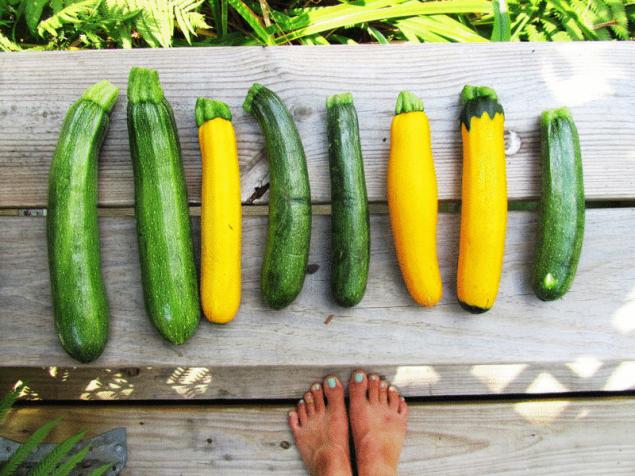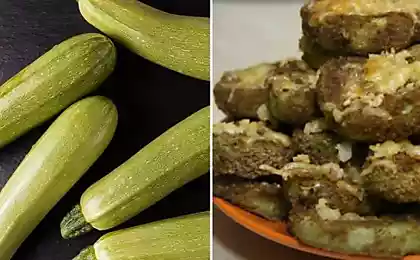631
Zucchini — the perfect diet product

Zucchini will help to get rid of excess weight small Squash varieties (zucchini) are among the most popular in Europe and America, representatives of the gourd family (Cucurbitaceae, cucurbita-pepo). It is believed that the zucchini have their origin from Central America and Mexico. They grow in the warm season, when there is no frost. Almost all vegetables of the gourd family have smooth skin and resilient flesh with small edible seeds. Pumpkin contain a lot of liquid. Courgettes (zucchini) form thickets, in contrast to the winter pumpkin that grow like grapes. Zucchini can be ready for harvest in 40-50 days after sowing.
However, any, even the most healthy foods you can add to your diet only after consulting a doctor and in the absence of contraindications.
Golden zucchini is famous for its beautiful Golden-yellow color of their rind, which preserves color even after cooking.
Round zucchini varieties are dense, heavy and almost without seeds. Characterized by a smooth surface.
Zucchini "Tatum" (Tatume) common in Mexico. They look like a round zucchini, but have an oval shape and quite large.
"Costata romanesco" (Costata romanesco), also known as "Cocozelle" (Cocozelle), an elongated arrow shape with a small bulge on the back end. They have a ribbed surface and mottled green skin. Young and dense squash this variety is juicy and sweet.
Middle Eastern varieties of courgettes dense, green. They are characterized by thick dark-green stems, smooth, shiny skin and firm crisp and aromatic flesh.
Yellow squash "Crookneck" have thick rough skin with a noticeable bend from the stem.
Use zucchini for healthZucchini are one of the most low-calorie vegetables and have a caloric value just 17 calories per 100 grams. Their peel is a good source of dietary fiber, which allows to counteract the constipation and provides some protection against cancer of the colon.
Antioxidant value (ORAC, Oxygen radical absorbance capacity) zucchini, reflecting the ability to absorb free radicals is 180 TE. It is much lower than some fruit and vegetables. The zucchini are among the most common vegetables include dieticians to reduce weight and control cholesterol levels.
Zucchini, in particular their varieties with Golden rind, are rich in flavonoid polyphenolic antioxidants including carotenes, lutein and zeaxanthin. These compounds eliminate the body of damaging free radicals of oxygen and its reactive forms (reactive oxygen species). These forms of oxygen play a role in the course of various diseases and the aging process.
Zucchini contain relatively moderate amounts of folic acid — 24 micrograms per 100 grams, which is 6% of the recommended daily allowance. Folic acid plays an important role in cell division and DNA synthesis. Taken in sufficient quantity in the early stages of pregnancy, it helps prevent defects in neural tube development of the fetus.
They are also a good source of potassium, an important intracellular electrolyte. Potassium is beneficial for heart electrolyte and helps reduce blood pressure and heart rate, counteracting upward pressure effect of sodium.
Fresh zucchini is rich in vitamin A, which they contain 200 IU (international units) per 100 grams. Courgettes — good source of antioxidant vitamin C.
In moderation they also contain B-complex vitamins, including thiamin, pyridoxine, Riboflavin and minerals like iron, manganese, phosphorus and zinc.
Choosing and storing zucchini
Zucchini season is late spring and summer. In stores give preference to small or medium sized zucchini with a bright green skin, firm and dense to the touch. The best size is from 15 to 20 centimeters in diameter to 5 inches. Some of the major varieties of courgettes are grown especially for stuffing. Small surface scratches and blemishes do not make zucchini worse.
Avoid overripe, too big zucchini with dents and vegetables soft or loose texture. Also avoid squash with wrinkled edges, which have long been lying and had lost some moisture.
At home place them in a plastic bag and store in the office fridge for vegetables at the appropriate relative humidity. Zucchini should be stored no more than 2-3 days.
Before cooking the zucchini and rinse under running cold water. Sometimes they need a little scratched in places where they stuck the mud. Cut both tip of each sprout. Clean the squash from the rind is not recommended.
Zucchini flowers are edible and are a delicacy. They are usually collected in the morning when they are fresh and soft.
Nutritional value of zucchiniIn parentheses are the percentage of the daily allowance. Nutritional value is based per 100 grams of fresh zucchini (Cucumis pepo) with the skin according to information from the Ministry of agriculture of the USA, shown in the resource Nutrition And You.
General information:
energy value 17 kcal ( carbohydrates — 3.11 grams (2.5 percent);
protein — 1.21 grams (2%);
fats and 0.32 gram (1%);
fiber, part food — 1 gram (3%).
Vitamins:
folic acid (vitamin B9) is 24 micrograms (6%);
nicotinic acid (vitamin B3) — 0,451 milligram (3%);
Pantothenic acid — 0,204 milligram (5%);
pyridoxine (vitamin B6) — 0,163 milligrams (13%);
Riboflavin (vitamin B2) — 0.094 milligrams (7%);
thiamine (vitamin B1) — 0.045 milligrams (4%);
vitamin a, which very much is contained in dandelion — 200 international units (IU, IU) — 7%;
vitamin C — 17.9 mg (30%);
vitamin E — 0.12 mg ( vitamin K, an incredibly rich source of which is sage — 4.3 micrograms (4%);
Electrolytes:
sodium — 8 milligrams (0,5%);
potassium 261 mg (5.5 percent).
Minerals:
calcium, 16 milligrams (1,6%);
iron 0.37 mg (5%);
magnesium — 18 mg (4%);
manganese — 0,177 mg (8%);
phosphorus 38 milligrams (5%);
selenium is 0.2 micrograms ( zinc — 0.32 milligram (3%).
Phytonutrients:
beta-carotene (ß-carotene), which is rich in carrots — 120 micrograms;
beta-cryptoxanthin (ß-cryptoxanthin) — 0 micrograms;
lutein-zeaxanthin — 2125 micrograms. published
P. S. And remember, only by changing their consumption - together we change the world! ©
Source: hi-news.ru























